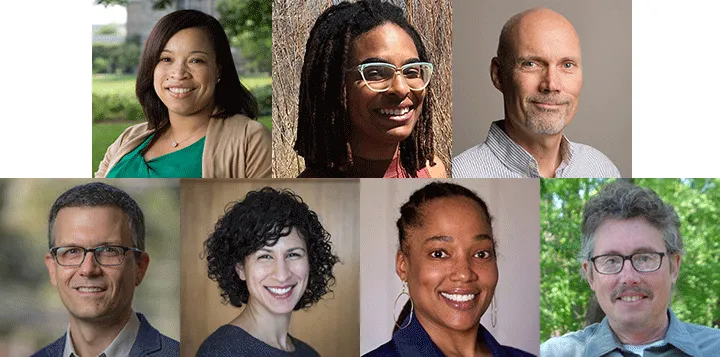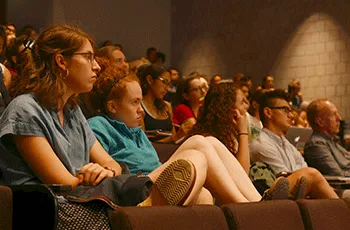Interdisciplinary Faculty Panel Reflects on Charlottesville

Clockwise: T. Shá Duncan Smith, Jamie Thomas, Bruce Dorsey, Peter Schmidt, Nina Johnson, Sangina Patnaik, Lee Smithey.
“We are in a way in the midst of an emergency.”
With this remark, William R. Kenan, Jr. Professor and Department Chair of English Literature Peter Schmidt opened a teach-in this month entitled “What Happened in Charlottesville? How to Confront White Supremacy in All Its Forms.”
Schmidt and Associate Dean for Diversity, Inclusion, and Community Development T. Shá Duncan Smith moderated a panel of five professors representing five different departments, asking them to reflect on the events that took place in Charlottesville, Va., last August through the lens of their disciplines. The often-emotional discussion also drew questions and reflections from the audience.
Professor of History Bruce Dorsey began with a short presentation on the history of Confederate monuments. He explained that while the media and politicians like President Trump have argued that the removal of Confederate monuments constitutes an erasure of history, the monuments were actually created to present a false historical narrative and to exclude the history of African Americans in the south.
Most Confederate monuments were not erected immediately after the end of the Civil War to honor fallen soldiers, he notes. The peak period of construction was the first two decades of the 20th century — the Jim Crow era, which supported segregation, racial violence, and legal disenfranchisement. Many monuments that we see in southern cities today are directly tied to the reestablishment of the KKK, Dorsey says. They portray a narrative known as the Lost Cause, insisting that the Civil War was not about slavery, that slaves were happy and loyal before the war, that emancipation was bad for African Americans, that white southerners were the true victims. This false narrative is an act of erasure of the real history of the Civil War and Reconstruction. He pointed to the report of the Blue Ribbon Commission appointed by the Charlottesville City Council, which included "one of the most reasoned assessments of how a community might either move a monument, or more likely, built bigger and better truthful historical monuments that could dwarf the existing Confederate monuments."

The often-emotional discussion also drew questions and reflections from the College community.
Assistant Professor of English Literature Sangina Patnaik spoke next, considering defenses of free speech and the permeability of college campuses. She noted the prevalent view on the far right that college campuses are liberal echo chambers but argued that “the college campus is not inoculated against the events that are occurring around us.” College campuses are spaces where free speech is debated and protected and thus have become places that white supremacists target, she notes.
Patnaik examined the use of free speech as an effective tactic of white supremacists: speech only loses protection when it can be shown to lead to imminent lawless action. However, white supremacists use the idea of free speech as it is promoted by privilege, explains Patnaik. She projected a series of contrasting images: white supremacists protesting while holding firearms and unarmed black men shot by police officers. Certain bodies have more freedom of speech than others, and this privilege of speech translates onto college campuses. Far right advocates have made college campuses their targets, and they require payment for the speakers they bring in, Patnaik says. This can be enormously costly. The value and protection that speech receives is highly dependent on the identity of the speaker.
The discussion continued with Assistant Professor of Sociology Nina Johnson. She analyzed the events in Charlottesville in terms of symbols, which represent the distribution of power. While white men are winning by all indicators of social outcomes, Johnson notes, they still see themselves as aggrieved.
Next, Associate Professor of Sociology and Peace & Conflict Studies Lee Smithey remembered his childhood growing up in Nashville, Tenn., on Robert E. Lee Drive, and attending a private school that was created in the wake of desegregation. The school's principal kept a Confederate uniform in his office and would wear it on special occasions, and the school proudly displayed other Confederate symbols. Smithey noted that all this took place in a deeply segregated city surrounded by trappings of the history of a campaign to maintain slavery, and that there was not nearly enough discussion about this history. Regarding Charlottesville, he explained that white supremacist demonstrations are related to a long process of normalizing the Confederacy by distancing it from its roots in slavery. Smithey argued that it may be counterintuitive, but controversial public symbols can ultimately act as vehicles for peacebuilding work if they become sites for constructive debate and relationship-building.
Assistant Professor of Linguistics Jamie Thomas capped the panel by analyzing how language can support racism. She explained that social histories are constructed by and result in language: we learn to call ourselves by our identities — Americans, Black Americans, Swatties — and that these words in turn tell us who we are. Language also shows us the hyper-visibility and invisibility of certain bodies. We use phrases like “woman doctor” and “Black student,” and this over-lexification can help us identify covert racism in our speech patterns, she says. On the other hand, language often excludes certain groups and teaches us to become comfortable with their absence.
Finally, Thomas discussed the idea of the communicative burden, or a burden between speakers and hearers. Meaning is only achieved when a hearer correctly interprets a speaker’s language, Thomas notes. She related the idea of a burden back to Charlottesville and recalled her first thoughts when she, a woman of color, saw photos of the white supremacists marching with tiki torches: “Great, this is something else I have to deal with.” Linguistics and other fields have historically supported racism, she notes, but linguistics also speaks to the need to listen and share burdens.



